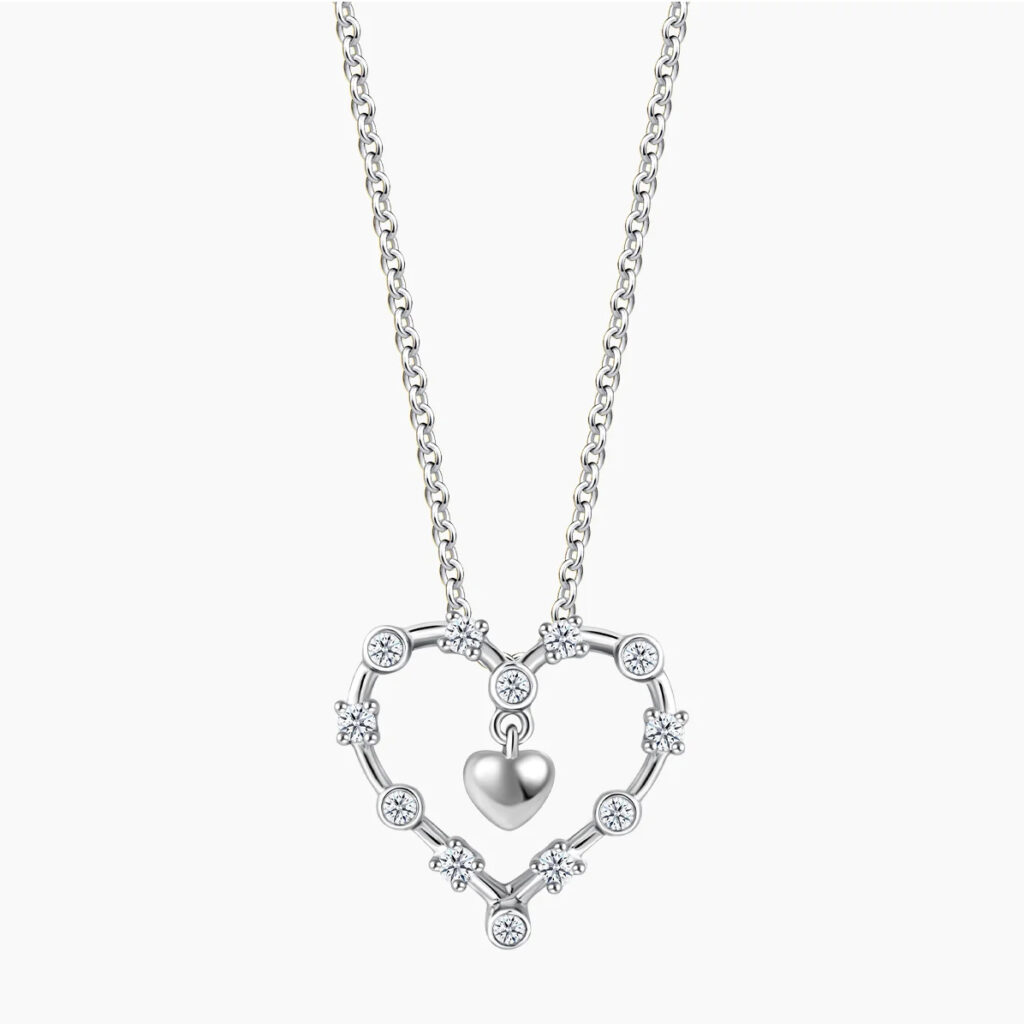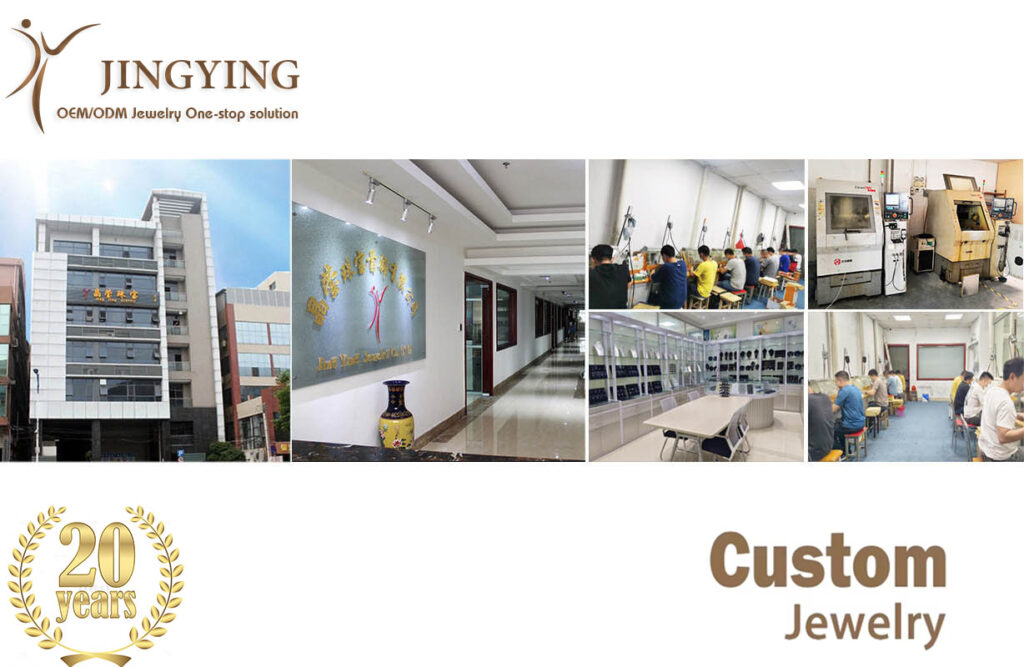Hur man skapar ett kärlekshalsband på kärleksform på Sterling Silver: En resa från koncept till utsmyckning
Hjärtformen är mer än bara en symbol; det är ett universellt språk. Det talar om kärlek, tillgivenhet, vänskap, och djup känslor. När du är utformad till ett hänge och hängde från en sterling silverkedja, det blir en personlig talisman, Ett smycken som är genomsyrat av mening och känsla. Att bära en kärleksformad hänge är att bära ett meddelande nära ditt hjärta. Att skapa en är en konstverk, precision, och djupt personligt uttryck.

Resan för att skapa en Sterling Silver Love Shape Pendant -halsband är en fascinerande alkemi med forntida tekniker och modern teknik. Det är en process som är tillgänglig för en hobbyist med några handverktyg och en professionell tillverkare som driver industriella maskiner. Denna omfattande guide leder dig genom varje steg på denna resa, utforska både den intima omfattningen av hantverksjuvelerarens bänk och den expansiva driften av en anläggning som Junge, ledande inom tillverkning av anpassade silversmycken. Oavsett om du är en blivande designer, ett varumärke som vill förstå produktionen, eller helt enkelt en nyfiken entusiast, den här artikeln kommer att belysa vägen från en enkel idé till ett färdigt objekt av skönhet.

Del 1: Stiftelsen – Förstå Sterling Silver
Innan den första skissen ritas, man måste förstå duken. Sterling silver är det valda materialet för detta projekt för sin skönhet, bearbetbarhet, och värde.
-
Vad är Sterling Silver? Rent silver, känd som “fint silver,” är för mjuk för de flesta smycken. Det skulle lätt repa sig, böja, och tappar sin form. För att göra den hållbar, den är legerad med 7.5% Andra metaller, nästan alltid koppar. Detta skapar ett material som är 92.5% rent silver — därav “925” stämpel, Ett kännetecken för äkthet. Kopparen tillför styrka utan att avsevärt minskar det lysande, värma, vit glans av silver.
-
Varför sterlingsilver för en hänge?
-
Varaktighet: Det är tillräckligt starkt för att hålla detaljerade former (som ett hjärtas kurvor) och tål dagligen slitage.
-
Hypoallergen: Dess höga renhet gör den lämplig för de flesta med känslig hud.
-
Bearbetning: Det är relativt mjukt jämfört med andra metaller, gör det idealiskt för sågning, arkivering, lödning, och stämpling.
-
Mottaglighet för att avsluta: Det kan poleras till en spegel glans, Med en mjuk matt finish, eller oxiderad för att skapa antik, Kontrasterande effekter som belyser hjärtas detaljer.
-
Värde: Det ger utseendet och känslan av lyx till en mycket mer tillgänglig prispunkt än platina eller guld.
-
Del 2: De två skapelsesvägarna
Det finns två primära sätt att skapa en kärleksformhänge: handtillverkning och gjutning. Vilken metod som väljs beror på det önskade resultatet, skala, och resurser.
-
Metod A: Handtillverkning (Hantverkarens tillvägagångssätt) Detta är processen att skapa ett unikt föremål direkt från silverplåt och tråd med hjälp av handverktyg. Den är idealisk för unika föremål, prototyper, eller en djupt praktisk kreativ upplevelse.
-
Metod B: Gjutning (Tillverkningen & Tillvägagångssätt för små partier) Detta innebär att skapa en modell av hjärtat (ofta genom 3D-utskrift) och sedan använda den för att skapa en form. Smält silver hälls sedan i denna form för att skapa hänget. Detta är den metod som används av tillverkare som Junge att producera konsekvent, högkvalitativa bitar i valfri kvantitet, från ett dussin till tiotusentals.
Vi kommer att utforska båda vägarna i detalj.
Väg A: Konsten att tillverka hand
Det är här magin börjar vid juvelerarens bänk. Processen är meditativ och kräver tålamod och en stadig hand.
Steg 1: Design och konceptualisering
Allt börjar med en idé.
-
Skissen: Börja med att skissa ditt hjärta. Är det en klassiker, symmetriskt hjärta? En modern, geometrisk tolkning? En organisk, ojämn “hjärtat av havet” stil? Har den ett utskärningscentrum? Blir det en fast form? Skissa olika storlekar och proportioner.
-
Mått: Bestäm den slutliga storleken. Tänk på kedjan den kommer att hänga från - ett delikat 1 cm hjärta för en tunn kedja eller en djärv 3 cm statement-del för en tyngre kedja.
Steg 2: Överföra designen
-
Materiel: Sterling silver ark (18-20 gauge är en bra tjocklek för ett hänge), sågblad, en skrivare, och maskeringstejp.
-
Behandla: Skriv ut eller rita din färdiga hjärtdesign på papper. Använd en liten bit maskeringstejp för att fästa den direkt på silverarket. Använd en rits eller en vass syl, spåra konturerna av hjärtat, trycka ner för att repa designen på metallytan under.
Steg 3: Sågning av formuläret
-
Verktyg: Juvelerares sågram och ultrafina sågblad (a 2/0 eller 3/0 bladet är idealiskt).
-
Behandla: Fäst silverplåten på en bänkstift. Trä in bladet i ramen med tänderna pekande nedåt och mot handtaget. Spänningen bör vara tillräckligt hårt för att producera en hög “ping” ljud när det plockas. Smörj bladet med bivax. För försiktigt in bladet genom ett pilothål borrat inuti designen (för invändiga utskärningar) eller börja vid kanten. Följ den skrivna linjen med ett stöd, upp och ner rörelse, låta verktyget göra jobbet. Vänd metallen, inte sågen, för att navigera i kurvor.
Steg 4: Arkivering och raffinering
-
Verktyg: En uppsättning nålfiler (platt, halvrunda, runda, hårspänne).
-
Behandla: De sågade kanterna blir grova. Använd filerna för att jämna ut hela omkretsen av hjärtat. Använd en platt fil för raka kanter och en halvrunda eller rund fil för kurvorna i toppen och botten av hjärtat. Fila endast i en riktning för en jämnare finish. Detta steg är avgörande för att uppnå ett professionellt utseende.
Steg 5: Slipning och förpolering
-
Materiel: Sandpapper eller slipkuddar i allt finare korn (TILL EXEMPEL., 220, 400, 600, 800, 1200).
-
Behandla: Börja med det grövsta gruset för att ta bort alla filmärken. Sand åt ett håll. Flytta till nästa finare korn, slipa vinkelrätt mot föregående riktning för att säkerställa att du har tagit bort alla repor från föregående steg. Fortsätt denna process fram till 1200 grus för en nästan matt, slät finish redo för slutlig polering.
Steg 6: Lägger till borgen
Borgen är öglan som kedjan passerar genom.
-
Alternativ 1: Löd borgen. Skär en liten bit sterling silvertråd eller använd en förlagd borgen. Böj det för att forma. Med hjälp av en fackla, hårdlöd, och flöde, Löd försiktigt borgen till toppen av hjärthängen. Detta är den starkaste metoden.
-
Alternativ 2: Borrning. Borra ett litet hål genom toppen av hjärtat. Skapa en hoppring från silvertråd, Tråd den genom hålet, och löd det stängde. Detta skapar en sömlös slinga.
Steg 7: Slutpolering
-
Verktyg: Rotationsverktyg (som ett forom eller dremel) med muslinbuffande hjul, poleringsföreningar (Tripoli för skärning, Rouge för hög glans).
-
Behandla: Fäst hängen säkert till en dorn eller håll den med pincett. Applicera Tripoli -förening på ett hjul och arbeta hängen tills alla fina repor har tagits bort. Byt till ett rent hjul med rouge -förening och buffra hjärtat till en lysande, spegelfinish.
Steg 8: Lägga till en patina (Frivillig)
För att få detaljerna att dyka upp, speciellt om hjärtat är strukturerat eller graverat, en antik finish kan appliceras.
-
Behandla: Använd en kemisk oxidationsmedel som lever av svavel för att mörka hela hänget. Sedan, med hjälp av en polerkudde indränkt i tvålvatten, gnugga försiktigt höjdpunkterna i designen, lämnar urtagen mörka. Detta skapar vacker kontrast och djup.
Steg 9: Montering
Fäst ditt nyskapade kärleksformade hänge på en kedja i sterling silver som du väljer. Ditt unika föremål är komplett.
Väg B: Precisionen av gjutning (JINGYING-metoden)
För att producera flera identiska hängen eller mycket komplexa mönster som är svåra att såga för hand, gjutning är den föredragna metoden. Detta är den industriella processen som fulländas av tillverkarna.
Steg 1: Digital design och CAD-modellering
-
Behandla: Istället för en handskiss, en designer använder datorstödd design (Kad) programvara för att skapa en exakt 3D-modell av hjärthänget. Detta möjliggör otrolig precision, perfekt symmetri, och införlivandet av intrikata detaljer som skulle vara omöjliga för hand.
-
Fördelar: Designen kan enkelt ändras, skalad, och optimerad för gjutning. På Junge, CAD-designers arbetar nära kunderna för att omvandla deras koncept till tillverkningsbar digital verklighet.
Steg 2: 3D -tryckning (Snabb prototyp)
-
Behandla: Den digitala CAD-filen skickas till en högupplöst 3D-skrivare. Skrivaren bygger modellen lager för lager av ett speciellt gjutvax eller ett harts som brinner ut rent. Detta skapar en perfekt fysisk prototyp av hjärthänget.
-
Fördel: Kunden kan hålla, undersöka, och godkänna detta “3D utskrift” innan någon dyr metall används. Junge förlitar sig på detta steg för att säkerställa kundnöjdhet och undvika kostsamma misstag senare.
Steg 3: Formframställning
-
Behandla: Den godkända vaxmodellen är sprudad (fäst vid ett vax “träd” med andra modeller för massproduktion). Detta träd placeras sedan i en stålkolv, och en flytande investeringsgips hälls runt den. Gipset sätter sig i en hård form.
Steg 4: Utbrändhet och gjutning
-
Utbrändhet: Kolven placeras i en ugn, och vax/hartsmodellen inuti smälts bort (“förlorad”), lämnar en perfekt ihålig hålighet i form av hjärthänget. Detta är känt som “tappad vaxgjutning” metod.
-
Gjutning: Kolven avlägsnas från ugnen medan den fortfarande är varm och placeras i en vakuumgjutmaskin. Sterling silverkorn smälts i en degel och kastas sedan med centrifugalkraft eller sugs in i den ihåliga håligheten med vakuum, fyller varje minuts detalj.
Steg 5: Devestering och städning
-
Behandla: När silvret har svalnat och stelnat, gipsformen släcks i vatten, får den att bryta sig loss från silverträdet. De grova silverhängena, nu fäst vid silvret “sprue,” är avskurna.
Steg 6: Efterbehandling, Putsning, och kvalitetskontroll
Det är här som rågjutgodset blir smycken.
-
Trumling: Hängen placeras i en tumlingsmaskin med stålkulor och tvålvatten för att jämna ut ytor och arbetshärda metallen.
-
Hand efterbehandling: Eventuella kvarvarande gjutgrindar arkiveras bort. Skickliga polerare polerar sedan varje hänge till den specificerade finishen (hög glans, matt, etc.).
-
Rigorös QC: På Junge, varje enskilt hänge genomgår en flerpunktskontroll för defekter, finish kvalitet, och dimensionell noggrannhet. Detta säkerställer att endast perfekta bitar rör sig framåt.
Steg 7: Montering och förpackning
De färdiga hängen i kärleksform är ihopkopplade med kedjor i sterling silver av hög kvalitet, placeras i specialmärkta förpackningar, och förberedd för global leverans.
Slutsats: Hjärtat smidd i silver
Att skapa ett halsband med kärleksform av sterling silver är en djupt givande process, oavsett om det utövas som ett personligt hantverk eller ett professionellt företag. Den förbinder oss med en tradition av utsmyckning som sträcker sig över årtusenden, så att vi kan skapa påtagliga symboler för våra mest immateriella känslor.
Handtillverkningsmetoden erbjuder den själfulla tillfredsställelsen att skapa något unikt av råvaror, en direkt översättning av tanken till form. Gjutmetoden, som behärskas av tillverkare som Junge, demokratiserar denna skönhet, gör det möjligt att dela en enda vacker design med världen, se till att varje del är lika perfekt och hållbar som den känsla den representerar.
Till slut, oavsett om det skapas av ett enda par händer på en tyst bänk eller av den synkroniserade dansen i en modern fabrik, ett kärlekshänge i sterling silver är mer än en accessoar. Det är en berättelse, ett löfte, och en bit av hjärtat, given form i en av de vackraste metallerna på jorden.
